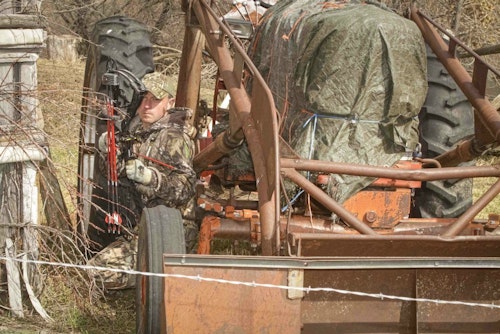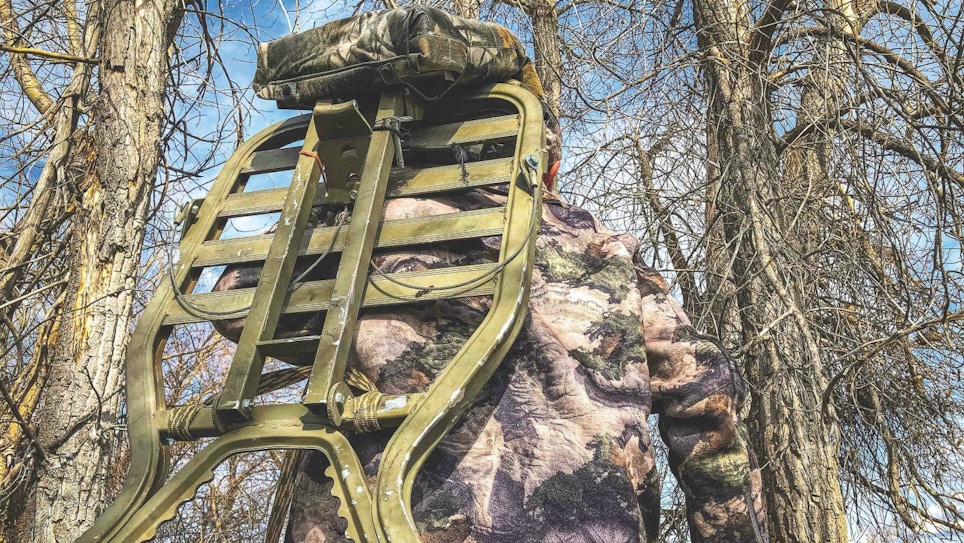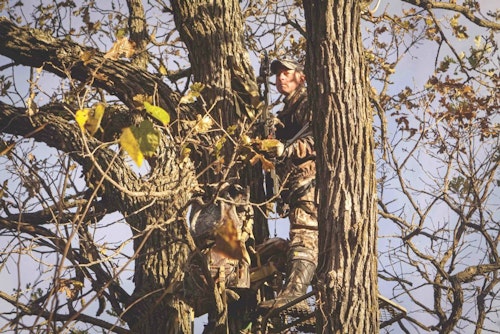You are a trespasser. You could fight that title, but it’s for naught. Every time you step foot in the whitetail woods, you’re trespassing on the turf of one of nature’s most attentive tenants.
Since the majority of whitetail bowhunters hunt from stands, your mission it to trespass with invisibility. To do that, you need to make your stand go away, at least in the minds of these vigilant occupants.
Early Set Up
Time may not be on your side for this tactic but add it to your “to-do” list even this late in the game. Early set up is the best recipe for a stand or blind to go away in any whitetail neighborhood. It won’t disappear, but a ground blind addition or a treestand set up disruption slowly fades over time too resident deer. You may spook deer during the initial hubbub while staking, hanging and trimming, but within a week or less, deer will be back to a regular routine. Your intrusion and new subdivision will be a distant memory.
If you didn’t hit a late-summer deadline, you can still make your intrusions less impactful with timing. Time your set up with an upcoming distraction. Is the farmer going to be harvesting? Is a roundup of livestock on the calendar? Is a nephew going to cut firewood with a chainsaw some Saturday? Does your HuntStand hunting app forecast a high wind or downpour event soon? Deer routinely get jostled around their home territory by activities like these, and wind and rain veils many undertakings. Simply disappear in the commotion and get your ambush in place.
Foliage High and Low
Foliage may be falling as fall progresses, but that doesn’t mean you can’t utilize it to make your stand go away. A buddy of mine from corn country routinely uses the stalk jungle of standing corn to make his ground blinds disappear, with the farmer’s permission, of course. He scouts corners or edges of cornfields that funnel deer along strips of cover and then sets the blind just inside the field. The setup robs a handful of ears of corn, and with a bit of scavenging, he picks up natural-looking fallen stalks to screen the remainder of the blind. After a few days, deer won’t look twice at the corny hideout. Of course, be sure to remove it before harvest, or you won’t be allowed on that farm again!
You have several options above terra firma. For starters, try to locate a tree with multiple limbs where your treestand will melt into the backdrop. Stands on tall, bare trees tend to stick out regardless of height. Big, branching oaks are my favorites, but even a tall, brushy cedar has hideout possibilities. My buddy Greg Gilman sells whitetail properties in northeast Kansas, and he routinely carves out stand sites in the numerous cedars of the Flint Hills for invisible high hides.
You can also bring a bag of zip ties along and snip nearby limbs with lots of leaves to attach around your stand to break up your silhouette. Another friend of mine even hauls tumbleweeds into the heights to stash in limb pockets around his treestand for a complete disappearing act. Deer aren’t agronomists, so use what you got to vanish above or below.

Focal Point
Out of sight is out of mind, and another option to meet that goal is to avoid having your hide be a focal point. First, set it far enough off the trail that deer don’t see it on a straightforward path. Deer have excellent peripheral vision, but if you’ve done your job, the blind or stand will already have melded with the backdrop. Set a treestand 10 to 20 yards off a main trail and try to stake a blind in a hidden hollow with a view to the trail. They won’t stand out when placed off to one side or another, plus it provides you with a perfect angling-away shot.
Your next goal is to have a backdoor entrance. This ensures every time you visit the hide that you’re not leaving visual or scent clues of your deadly intentions as you cross potential shooting lanes. Clearing a backdoor path and liberal use of odor-eliminating products such as Scent Killer, go a long way in making yourself go away in the deer woods. Remember, deer can pattern you just like you pattern them, and their evolutionary technology far outperforms your trail camera.
Use What You Got
You’ve heard the phrase “Use what you got,” and sometimes it’s right under your nose. The best hideouts are those that don’t raise a buck’s eyebrow. Junkpiles, abandoned farm machinery and dilapidated farm buildings are among an array of unobvious elements to use for existing ambush hides. Al Kraus owns Black Hills Archery and sets up my bows to perfection. He once shared a tale of how he tagged a monster whitetail by hiding in a jumble of old 55-gallon oil drums. Another buddy of mine sets up a chair in the window of a decaying farmhouse to arrow deer that visit an old, backyard apple orchard.
Think outside the box. You could use a hayloft door for a lofty perch (if deemed safe), make a comfortable hiding place from a wellhouse or disappear in the machinery operating an irrigation pivot. These same antique features offer extra stability for staked ground blinds while blending with an environment already familiar to local deer. And if harvesting is stopped for weather events, consider sitting underneath a parked combine on a cornfield edge.
You can’t escape the fact you’ll be trespassing this archery season in whitetail country. Despite this consequence, you can become a distant memory of whitetails. Just make your ambush site go away in the minds of local whitetails with innovative thinking.
Photos by Mark Kayser







